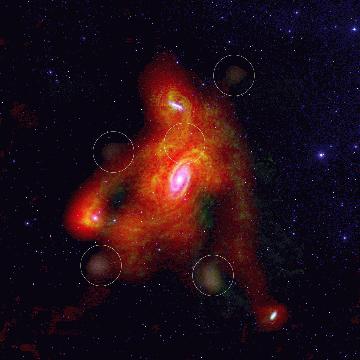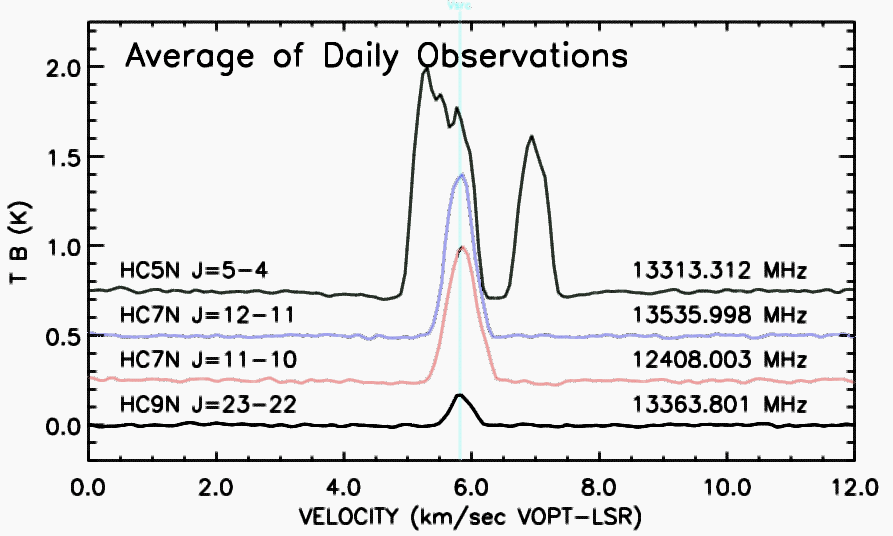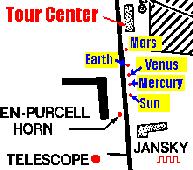
Scientist at Green Bank.

 |
Glen Langston Scientist at Green Bank. |
| The Green Bank Observatory is located in the beautiful mountains of West Virginia. We use radio telescopes to study the properties of giant molecular clouds in our galaxy, which are the sites of star formation. We also are part of a world wide Very Long Baseline Interferometry (VLBI) network that is used to study the physics of black holes at the center of active galaxies and quasars. |

|
| The whole sky is shown above, with the Galactic Plane A survey shown in color. The Galactic Center, Cygnus Region and Rosette Nebula are emphasized. Follow the link to select a region. |
|
Research |
HVCs and Galaxy Groups

Chynoweth, Langston and collaborators have used the GBT to discover new neutral hydrogen components of the M81/M82 group of galaxies. These clouds are thought to be analogs of the high velocity clouds (HVCs) surrounding our own galaxy. |
GBT Chemistry
 The GBT Astro-chemistry observations have been very successful.
The GBT Astro-chemistry observations have been very successful.
|
|
Ionospheric Studies
|
 Mathematica Free Fall Doppler Calculations
Mathematica Free Fall Doppler Calculations
A series of Mathematica calculations are presented outline the steps toward calculating the observations of a freely falling observer, as the approach a black hole. The first case considered is the free fall time from the Earth (1 AU) to the Sun. FYI the simple classical calculation yields a time of 64.6 days. The results are available in a Mathematica Notebook and a PDF. |
 Orbiting Very Long Baseline Interferometer
Orbiting Very Long Baseline Interferometer
The Orbiting VLBI tracking station in Green Bank, West Virginia is one of four NASA tracking stations dedicated to support of the space vlbi missions in Japan and Russia. The HALCA satellite is used to study the properties of jets of material ejected from the region surrounding black holes at the centers of distant galaxies. |
 Monitoring Our Galaxy
Monitoring Our Galaxy
The NRAO/NASA tracking station is being used to monitor the Milky Way Galaxy for transient radio sources. The first galactic plane survey at 8.35 and 14.35 GHz is available. In the movie to the right, the Cygnus X-3 (a binary star system in our galaxy) exhibited transient emission on 2000 April 20. The binary stars appear as a red peak in the center of one of the images. The radio emission of this region is compared to the Galactic Plane The GPA 8.4 GHz Survey image taken on 1998 September. The brightest emission is in red and faintest emission is in blue. The GP 8.4 image was taken on 2000 April 20 and has a higher noise level than the GPA image. The green emission differences are not significant. The ROSAT images shows the bright xray source. The Optical Digitized Sky Survey image (CYGNUS X-3) shows no significant emission because the system is imbedded in a dark cloud of gas.
|
 Gravitational Lens MIT Green Bank 1654+1346
Gravitational Lens MIT Green Bank 1654+1346
The MIT Green Bank survey of the sky at 5 GHz detected a number of gravitational lenses including the MG 1654+1345 system. In this system, a distant radio bright quasar is gravitational lensed by a closer foreground galaxy. This system was the first in which the mass of the lensing galaxy could be deduced based on the size of the lens image and the redshifts of the galaxy and quasar. |
|
Toney Minter, Frank Ghigo and I presented our first Space VLBI images of radio source 1413+135 . This radio source was observed with the VSOP spacecraft and the VLBA. Our Cospar Contribution is available ( LaTeX version ). |
|
High Redshift Radio Lines
Green Bank hosted the
High Redshift Radio Lines
workshop. The proceedings are available from the P.A.S.P.,
edited by C. Carilli, K. Menton, S. Radford and G. Langston.
|
|
High Redshift Absorption Lines Keri Eberhardt, Robert Brown and I observed a sample of high redshift (3.35 < z < 3.83) radio bright quasars, searching for HCN and CO absorption lines. This observations have yielded no detections, and we place limits on the column density of cold gas at high redshift. |
|
Publications |

An index of my publications is available, many with postscript copies available online. |
|
|


|
| Education Projects |
 Sun Tracking Telescope
Sun Tracking Telescope
|
 Internet Array for Science, Technology Development and Education
Internet Array for Science, Technology Development and Education
Preliminary plans for an Internet based antenna array are being
developed in an collaboration between West Virginia University,
Gifu University of Japan and NRAO.
|
|
The 140ft telescope has contributed to the discovered interstellar chemistry!
Many molecules have been first detected in interstellar space using
the 140ft telescope.
The chemical structure of these molecules is shown.
|
|
Star forming region DR-21 contains a wide variety of molecules and studied to understand interstellar chemistry. |
 Solar System Tour
Solar System TourThe NRAO solar system tour guide map is presented in a variety of forms. A scale model solar system has been set up on the NRAO site (scale 1:3,000,000,000). The locations and relative size of the sun and planets are shown. |
|
Resume My resume in PDF form. |
